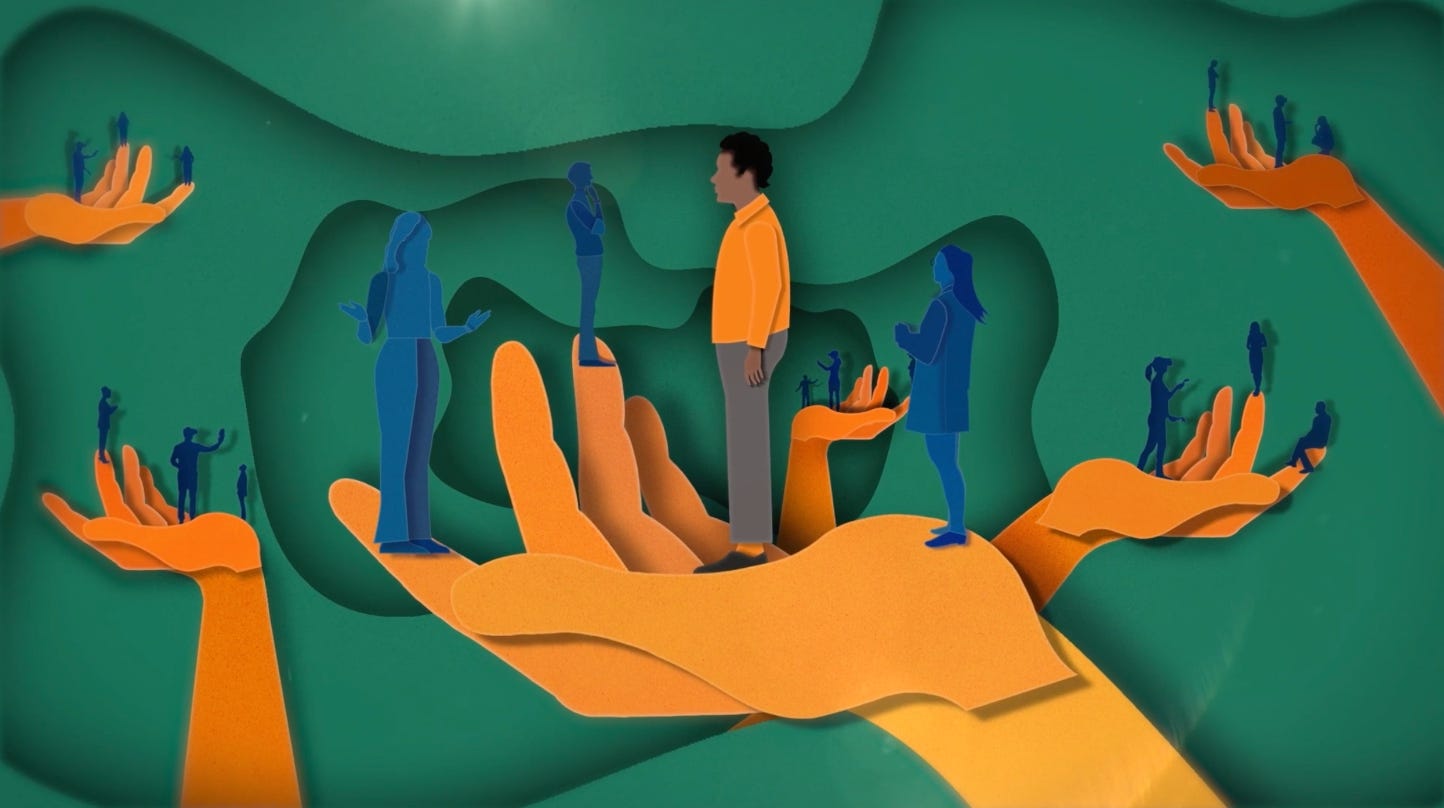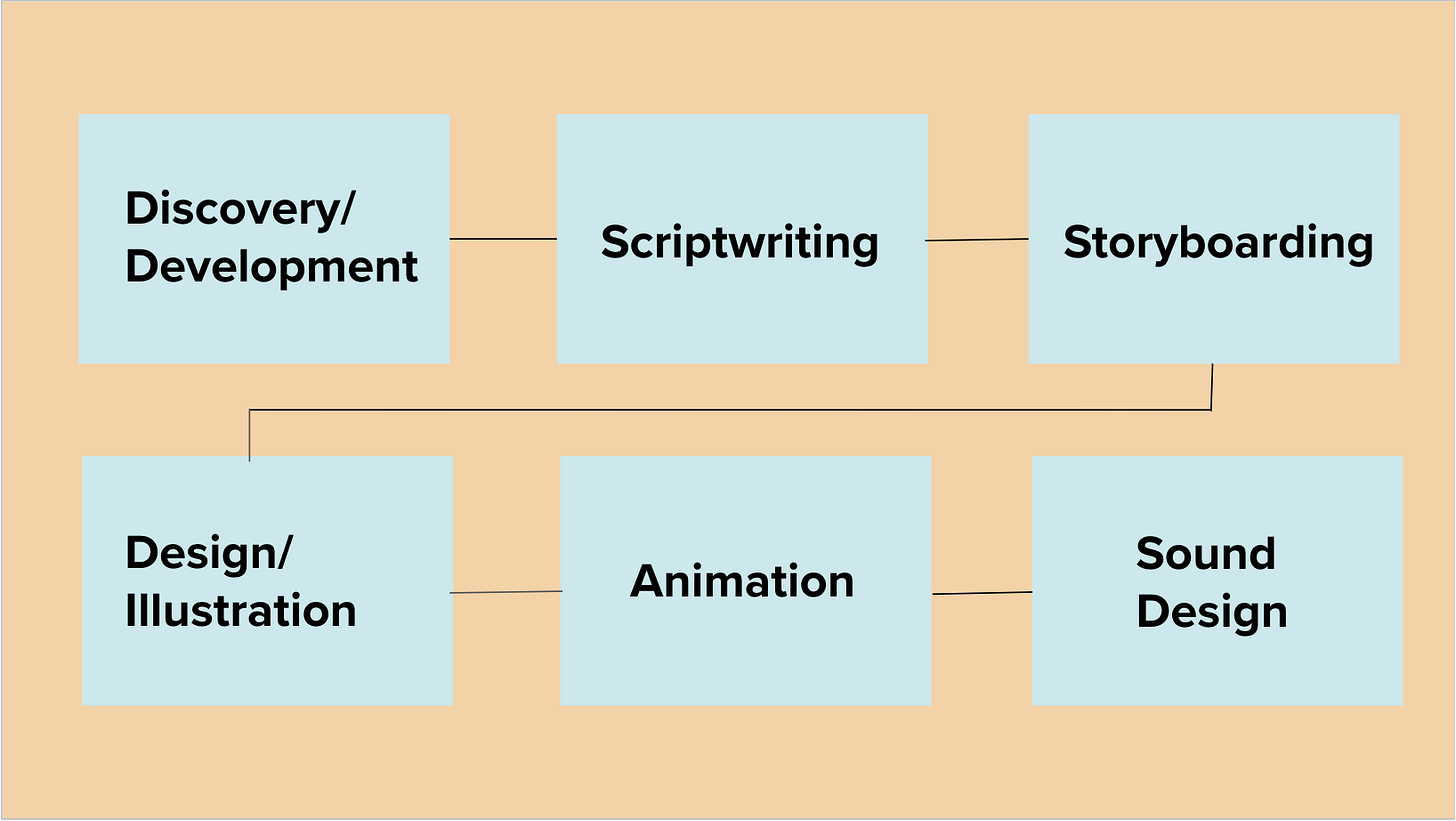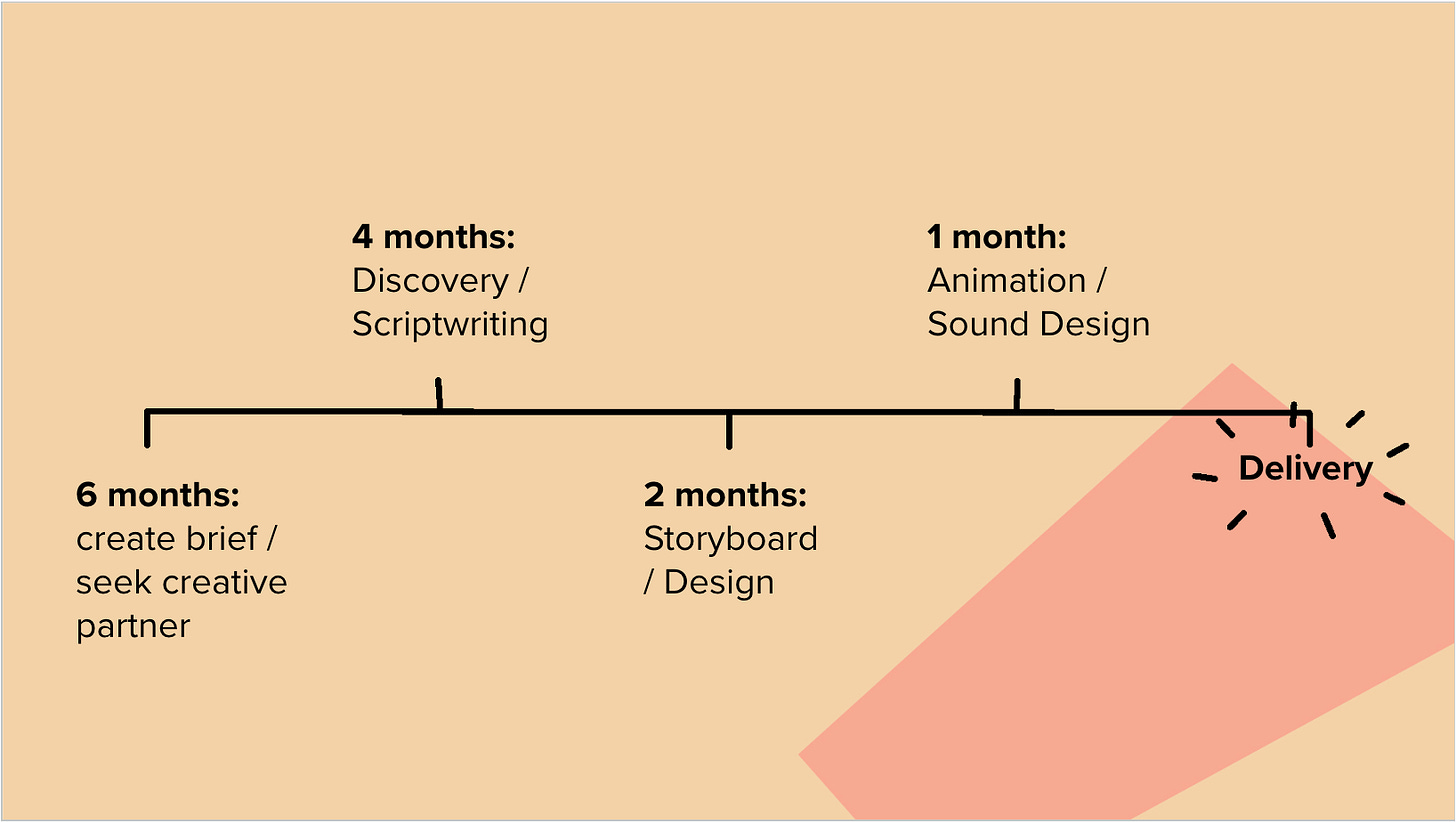Animations 101, Part 1: How Much Time Should You Allow?
The first part in our new series answering the most common questions we get about what it takes to make an animation about your research.
Hello!
A couple of months ago, we published a newsletter about our webinar: Using Animation to Boost Engagement with Research, which we created to answer some of the most common questions we get asked about research-focused animations.
Part 1: ‘How long do they take to make?’
Part 2: ‘How much do they cost?’
Part 3: ‘How can we make sure our animation gets seen by the right people?’
Part 4: ‘How can we get funding for animations?’
Of course, the ideal way to explore those questions is by booking one of our webinar sessions for your institute - delivered by yours truly - or by signing up to the public session that we’re opening up to everyone on Tuesday 5th November. Details on how to do both of those things are at the end of the this newsletter.
But for those of you who can’t do that, or who prefer to digest information in a written format, we’ve decided to share some of its contents here on the Research Comms newsletter.
Over the next couple of months, we’ll be tackling each of those questions one at a time.
So, without further ado…
Part 1: How long does it take to make an animation?
The reason we’ve chosen to answer this one first is because most people who’ve not commissioned an animation before underestimate how long it takes to make a decent one.
Why it matters?
Because people underestimate the time, we are often approached by research groups who want an animation at the last minute, by which point it might well be too late to hit whatever deadline they have.
It always feels like a massive shame when we can’t help a research group share their work, simply because they didn’t factor in enough time.
How long does it take?
We typically suggest a four month turnaround time to produce an animation of about two minutes in length.
Yes, it can be done faster than that if necessary. But four months is the sweet spot, allowing enough time to craft something that will look and sound fantastic and which, crucially, will have the impact you’re looking to achieve.
I’ll keep this next bit as brief as possible but to understand why it takes so long, it’s useful to first know a bit about how animations are made…
Six phases
At Orinoco Communications we divide the animation production process into six distinct phases:
Discovery Phase
Every production kicks off with a discovery session or workshop where we ask these questions…
‘Who are you trying to reach?’
‘Why would that audience want to watch your animation?’
‘What value will they get from doing so?’
Understanding the ‘who’, ‘why’ and ‘what’ is the primary goal of the Discovery Phase, which takes place before any script has been written, designs drawn, or voices recorded.
After the initial session we’ll do some more audience research of our own while our creative team comes up with ideas for what the look and feel of the animation should be, based on that research.
Scriptwriting
Animation is a highly visual medium but before we start sketching out any scenes, they have to be written.
The scriptwriting phase is where key messages and concepts are converted into a concise and engaging narrative. That might mean scripting a voice over, working with existing material, such as interviews, or a combination of the two.
Whatever the approach, it’s essential to make sure that the words are honed and fully approved before moving onto the next phase.
Storyboarding
This is the step when the words in the script take shape as images and scenes for the first time. They’ll probably be pretty rough at this point. Think black and white pencil sketches with stick people characters.
The storyboard is intentionally rough so that changes at this stage are easy to make. That means we can be quite playful and experimental throughout this phase.
Design/Illustration
Once the storyboard has been approved, those rough sketches are transformed into fully fledged designs or illustrations.
This is the first time you’ll start to get a sense of what the final animation will look like, even though the designs are still static at this point.
Animation
This is the phase when the animator finally breathes actual life into the static designs for the first time.
It’s always exciting to see the scenes that have been trapped on the page transform into living, breathing characters and designs!
Sound Design
“A man without a beard is like an egg without salt” as my grandmother used to say (which was odd, as my grandfather was completely beardless).
I would say the same salt/egg comparison goes for the phrase, ‘an animation without sound design…’
The best sound designers are absolute specialists, and their work has a big impact on defining the mood and character of an animation.
Without proper sound design animations can lack that extra oomph that makes them really stand out.
All of that is to say: a massive amount of creative and logistical work goes into the producing a single animation; as an agency we clock up around 25 days from start to finish.
Collaboration & Feedback
The reason it actually takes more than those 25 days to deliver the final product is because the process is highly collaborative.
We don’t just disappear off for four weeks then come back to our clients with the finished article.
We work closely with the researchers, of course, but more often than not there will also be other stakeholders involved too, e.g. people with lived experience, who provide invaluable feedback and guidance at key steps along the way.
Multiple rounds of review and revisions are scheduled at each phase of the production to ensure that the animation hits all the right notes.
It’s not a process that can be rushed.
That, in a nutshell, is why we recommend four months to produce an animation from start to finish.
Add a couple of months to the timeline to account for how long it can take to get contracts in place and all the procurement red tape sorted and you’re now at around six months:
What all this means for you
If you’re involved with a research project and you think an animation could help with recruitment or dissemination then start thinking about it early.
Getting the ball rolling five or six months before you need your animation to ‘go live’ means you’ll be setting yourself and your creative partner up for success.
How we can help
At Orinoco, we specialise in creating animations to communicate research. We’ve done that for research groups and organisations all over the world.
Check out some examples of our work here.
So, if you’re involved with a research project that would benefit from an animation, do get in touch. Ideally more than four months before it needs to be ready - for all the reasons stated in this newsletter!
But in certain circumstances - e.g. when few stakeholders are involved in decision making - we can compress timelines, so if you have less than four months it’s still worth getting in touch for a chat, as we might be able to help.
This newsletter is edited from a portion of our 30 minute webinar: Using Animation to Boost Engagement with Research.
We’re offering the webinar *free of charge* to research institutes. If you would like to schedule a session for your own research community please get in touch with me at peter@orinococomms.com.
We are also running an open session on Tuesday 5th November at 12.30pm. Individuals can register for that here: Register for Using Animation to Boost Engagement with Research





